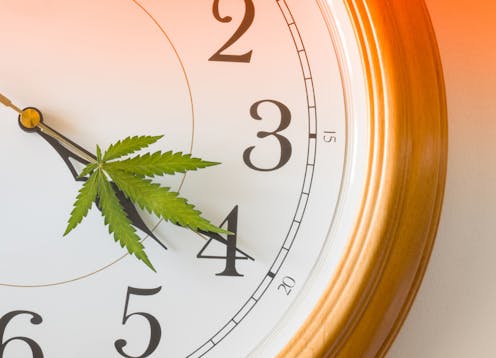
Imagine a world where you could control your sense of time. Where trips to the dentist flew by in a second and holidays felt like they lasted forever. Time altering pills may sound like science fiction but the time warping effects of psychoactive drugs suggest that deliberate time manipulation may be possible.
Drug induced time-warps are a widely reported phenomenon by recreational drug users. My 2022 study suggested that over 75% of people who had recently used cocaine, MDMA (also known as ecstasy) and cannabis reported distortions to the passage of time during drug use. The participants said the distortions were a pleasurable aspect of drug use.
Studies show that cocaine and MDMA (ecstasy) speed up our perception of time. Despite being able to party for longer after cocaine and MDMA, users may feel like their night was over faster because time flew by more quickly.
Cannabis, on the other hand, often leads to a sensation of time expanding. Minutes can feel like hours and evenings seem to last forever. Other drugs can scramble our sense of time completely.
Psychedelics such as LSD, DMT and mescaline produce a sense of timelessness. Prescription drugs can also distort time too. Pregabalin, a drug used to treat epilepsy and anxiety, and anti-anxiety drug Xanax, both slow the passage of time.
So why do drugs warp time?
Drugs have powerful effects on the way in which the brain processes the world around us.
They cause changes in chemical messengers in the brain called neurotransmitters. Drugs associated with increases in the passage of time are stimulants, which cause increased activity and excitation across the areas of the brain associated with cognitive function. The ones associated with a slowing of the passage of time are depressants, which cause decreases in activity across these areas of the brain.
Drugs also affect behaviour and emotions, both of which can twist our experience of time. Drugs such as cocaine and MDMA can have powerful effects on mood, inducing feelings of happiness and euphoria.
Studies show that during daily life, time passes more quickly during periods of positive mood and more slowly during dips in state of mind. This happens because some of the brain areas thought to be involved in timing are also responsible for emotion processing.
When these areas have to process emotion and time at the same time, distortions can happen. The high evoked by drug use may itself be a cause of drug induced distortions to time.
What you do while taking drugs will contribute to the sensation that time is bending. Immersing yourself in exciting activities, such as socialising with friends and dancing in clubs, draws our attention away from time. When you pay too much attention to time, for example when bored, time passes slowly.
The aftermath
What goes up must eventually come down. The neurochemical, emotional and cognitive effects of comedowns create the perfect environment for time to drag. For example, the high a person may feel while taking MDMA is caused by a massive release of a neurochemical (serotonin/5HT), and the three to five days after this are marked by low levels of serotonin while the brain replenishes.

These neurochemical changes also contribute to feelings of irritability, anxiety and depression. The combination of exhaustion and low mood means that much of the recovery period is spent wondering “when will this end”, which also exaggerates the slowing of time.
However, studies comparing people who have never taken drugs, with those who have taken cocaine, MDMA or cannabis in the last six months suggest there are no differences in their experiences of time when they are sober and have recovered from the come down.
Intertwined with human history and nature
The effects of drugs on our experience of time are primeval. Ayahuasca ceremonies, for example, are ancient spiritual rituals conducted by shamans or healers in South America. They involve drinking a liquid brewed from leaves from the Psychotria viridis shrub and stalks of the Banisteriopsis caapi vine.
The brew causes changes in the state of consciousness, resulting in hallucinations and a significant change in the flow of time.
Nowadays, ayahuasca ceremonies attract tourists from across the world seeking to experience altered states of consciousness and spirituality. Ayahuasca induced time-warps, in which time stops still, expands, or even disappears, remain a prominent feature of the experience.
Even animals are vulnerable to drug-induced time distortions. Rats are surprisingly good at judging time. They can be trained to press buttons at specific points in time in exchange for food. However, their ability to do this can be disrupted by drugs.
Giving rats cocaine or methamphetamine appears to speed up their representation of time, making them press the button earlier than they should.
Although drug-induced time warps are a side effect of recreational drug use, they demonstrate it is possible to recalibrate time in predictable ways. If scientists could harness the time-altering properties of recreational drugs, perhaps we could control our perception of time, instead of letting it control us.
Ruth Ogden receives funding from receives funding from The British Academy, The Wellcome Trust, The Economic and Social Research Council and CHANSE.
Cathy Montgomery receives funding from CSL Seqirus, Camurus AB, The Pain Relief Foundation and Phoenix Futures.
This article was originally published on The Conversation. Read the original article.







